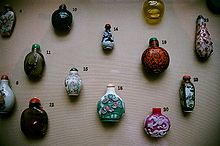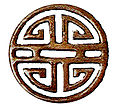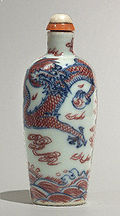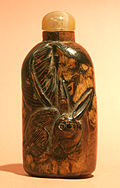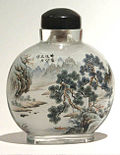- Snuff bottle
-
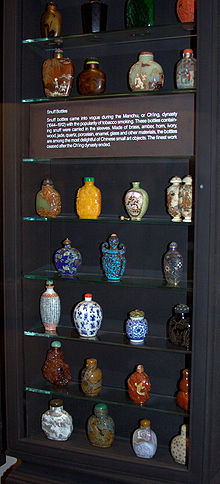 Snuff bottles in the American Museum of Natural History collection
Snuff bottles in the American Museum of Natural History collection
Snuff bottles were used by the Chinese during the Qing Dynasty to contain powdered tobacco. Smoking tobacco was illegal during the Dynasty, but the use of snuff was allowed because the Chinese considered snuff to be a remedy for common illnesses such as colds, headaches and stomach disorders. Therefore, snuff was carried in a small bottle like other medicines. The snuff bottle is comparable to the snuff box used by Europeans.
Tobacco was introduced to the court at Beijing some time during the mid- to late-16th century. It was originally smoked in pipes before the establishment of the Qing Dynasty. The use of snuff and snuff bottles spread through the upper class, and by the end of the 17th century it had become a part of social ritual to use snuff. This lasted through most of the 18th century. Eventually, the trend spread into the rest of the country and into every social class. It was common to offer a pinch of snuff as a way to greet friends and relatives. Snuff bottles soon became an object of beauty and a way to represent status. The highest status went to whoever had the rarest and finest snuff bottle. The peak of snuff bottle manufacture was during the 18th century.
The use of snuff increased and decreased with the rise and fall of the Qing Dynasty and died away soon after the establishment of the Republic of China. However, replica snuff bottles are still being made, and can be purchased in souvenir shops, flea markets and museum gift shops. Original snuff bottles from the Qing period are a desirable target for serious collectors and museums. A good bottle has an extra quality over and above its exquisite beauty and value: that is touch. Snuff bottles were made to be held and so, as a rule, they have a wonderful tactile quality.
Contents
Materials and size
The size of a snuff bottle is small enough to fit nicely inside the palm. Snuff bottles were made out of many different materials including porcelain, jade, ivory, wood, tortoiseshell, metal and ceramic, though probably the most commonly used material was glass. The stopper usually had a very small spoon attached for extracting the snuff. Though rare, such bottles were also used by women in Europe in Victorian times, with the bottles typically made of cut glass.[1]
Chinese snuff bottles were typically decorated with paintings or carvings, which distinguished bottles of different quality and value. Decorative bottles were, and remain, time-consuming in their production and are thus desirable for today's collectors.
Symbolism in snuff bottle decoration
Many bottles are completely devoid of decoration, others are incredibly ornate. As in all Chinese arts and crafts, motifs and symbols play an important part in decorative detail. Symbols are derived from a multitude of sources such as legends, history, religion, philosophy and superstition. The ideas used are almost always directed toward bringing wealth, health, good luck, longevity, even immortality to the owner of an artefact, frequently as a wish expressed in a kind of coded form by the giver of a gift. Probably the most popular decoration is the Shou character, a symbol of happiness and longevity, illustrated at right. Shou or Sau was one of Three Star Gods.
Another popular device is a representation of the 18 Lohan, who were the personal disciples of Buddha, just one group of the many revered immortals in China. Apart from the 18 Lohan there is a constellation of other divines who are portrayed, even their innards. The eight precious organs of the Buddha are venerated - his heart, gall bladder, spleen, lungs, liver, stomach, kidneys and intestines. These are rarely depicted on snuff bottles. Animals, on the other hand appear with regularity, the most common being the dragon.
A dragon is shown in the example at right on a porcelain bottle in splendid red and blue and clutching the inevitable fiery pearl. One of the traditions of Chinese art is that only the Emperor, his sons and princes of the first and second ranks were permitted to own an artefact illustrated with a dragon having five claws. Four-clawed dragons were restricted to princes of the third and fourth ranks, while the common folk had to be content with a dragon having three claws. However, it is common to find that many older bottles have dragons with five claws.
The horse is another animal frequently used in the decorative work. The horse is one of the Seven Treasures of Buddhism. Its symbolism points to speed, perseverance, rank, power and wealth. The symbolism of wealth and power came about because the horse carried those of importance. In the example at left, the horse seems to be carved in a very amateurish way, but in this school of bottle production, naïveté was the style.
The hare is also often found on snuff bottles. The example at right shows a hare on a bottle made of wood. The hare represents a wish for long life and even immortality. In Chinese tradition it is believed that if one attains a sufficiently high standard of morality and enlightenment, one will become one of the immortals.
Other commonly used symbols
The three legged toad is a mythical creature. It was thought to be an animated purse containing an inexhaustible supply of coins, hence it represents wealth and has become a symbol of the unattainable.
The fish is both an emblem of wealth and abundance and of harmony and connubial bliss. The fish emblem is used in a variety of decorative ways. Bamboo is a frequent motif. Because of its durability and its being evergreen it has come, along with many other symbols, to signify longevity.
"Inside painted" bottles
Without doubt, the class of bottle that arouses most interest in the non-collector is that known as inside painted. These are glass bottles which have pictures and often calligraphy painted on the inside surface of the glass.
These delightful scenes are only an inch or two high and are painted while manipulating the brush through the neck of the bottle maybe only a quarter inch across, and also painted in reverse. Ursula Bourne, in her treatise on snuff, suggests that artisans painted on their backs to make it easier to work through the narrow opening.[1] It has been said that a skilled artist may complete a simple bottle in a week while something special may take a month or more and that the best craftsmen will produce only a few bottles in a year.
The bottle at right is signed by a well-respected artist called Kuie Hsiang-Ku and is dated 1896.
The earliest inside painted bottles are thought to have been made in the period between 1820 and 1830 as, by then, the beauty of a snuff bottle was probably more important than utilitarian considerations—-and considering this—few would have been used for holding snuff. Inside painted bottles are still made today—expensively for collectors and inexpensively as souvenirs.
Like other types of snuff bottle, the range of subject matter used on inside painted bottles is without limit. There are scenes, fish, birds, poems, even portraits. They are testament to the skill and inventiveness of Chinese craftsmen.
Snuff bullet
In recent years a popular method of snuff insufflation has been the snuff bullet. A simple snuff bullet consists of a small bottle with a plug in the base, a rotatable "dosing chamber" and a hole on the top. More advanced snuff bullets have variable dosing settings. They can be made of plastic, glass or metal.
Notes
Further reading
- Low, Denis S.K. (2007). Chinese Snuff Bottles: From the Sanctum of Enlightened Respect III. Laurence King Publishing. ISBN 9810578865.
- Chinese Snuff Bottles: Masterpieces in Miniature by Eric J. Hoffman
External links
Categories:
Wikimedia Foundation. 2010.

